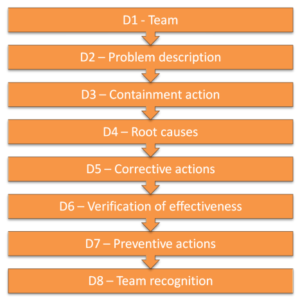What is the 8D Report?
Quality reports vary in format, size and application. I have seen all sort of documents serving the same single purpose – reporting on problem-solving of quality issues.
8D Report is a proven and practical approach to problem-solving.
From the simplistic point of view, all you have to do is to complete eight distinct sections of the report.

You will deliver excellent 8D Reports by following the professional advice presented in the article.
Why is 8D Report so powerful?
- Can be used by any business
- Can be modified, adapted to specific needs
- It’s surprisingly simple to use
- Provides comprehensive information to all parties
- It’s easy to follow by the reader
- Emphasises teamwork and responsibilities
- One report satisfies a whole lot of ISO 9001 requirements
You will impress Top Management by presenting this structured problem-solving technique.
8 steps to master 8D Report
Step 1 (D1) – The Team
I have seen people who completed this part as the last one, once the problem was solved. Was this the right thing to do? There is a reason why it’s called Step 1 (or D1 as some may say). 8D is a structured problem-solving technique therefore to maximise results all steps should be followed in order.
Think of everyone who can contribute to the solution (Including Yourself). Write down names and corresponding departments. Talk to your colleagues first instead of assuming that everyone will happily join the team. Writing down the names of people who are merely aware of the issues doesn’t make any sense.
The team should be formed by people who have committed to the task.
Last but not least the Team Leader should be chosen. It is not unusual for the initiator of the 8D Report to lead the process.
Step 2 (D2) – Problem description
Problem description triggers the entire 8D process. It comes from internal (line operator etc.) or external (customer) source. Form and level of detail provided may vary. In most of the case, people will tell you less than you would expect (“It doesn’t work anymore”, “I was told that there is a problem with it”, etc.)
My advice is not to spend too much time on the detail in the first place. You can always update the problem description later on. Realistically the investigation should highlight all the issues, and that will be one of the later steps.
Common mistake people make is to spend too much time on problem definition. They effectively walk into investigation territory prematurely.
You will make more progress by keeping the problem description simple. You are not writing a book. Focus on actions instead.
Step 3 (D3) – Containment action
When a problem occurs, you may need to take an immediate action to stop further spread. Many factors determine appropriate actions. Some of the elements may involve criticality of the issues (health & safety, spec issues, fit and function etc.)
Here are some containment actions that can be implemented in the manufacturing environment:
- Stop production line
- Quarantine stock of finished goods in the warehouse
- Quarantine stock of parts or subassemblies
- Stop further product shipments
- Bring products back to the factory
Step 4 (D4) – Root cause analysis
Many books have been written about root cause analysis as many proven tools can be used to get to the bottom of the problem. The rule of thumb is to use the one that is the most relevant to the nature of the issue. It’s good to start with a simple approach like brainstorming or 5Y before pulling out big guns.
Most of the root causes can be determined using a simple approach.
You can download a FREE copy of 8D Report template from the PREMIUM LIBRARY.



20 Comments
Leave your reply.